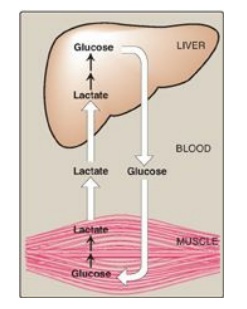Substrates for Gluconeogenesis
| Home | | Biochemistry |Chapter: Biochemistry : Gluconeogenesis
Gluconeogenic precursors are molecules that can be used to produce a net synthesis of glucose. The most important gluconeogenic prescurors are glycerol, lactate, and the α-keto acids obtained from the metabolism of glucogenic amino acids.
SUBSTRATES FOR GLUCONEOGENESIS
Gluconeogenic
precursors are molecules that can be used to produce a net synthesis of
glucose. The most important gluconeogenic prescurors are glycerol, lactate, and
the α-keto acids obtained from the metabolism of glucogenic amino acids. [Note:
Alanine, which directly gives rise to pyruvate, is an important example of a
glucogenic amino acid.]
A. Glycerol
Glycerol is released
during the hydrolysis of triacylglycerols in adipose tissue and is delivered by
the blood to the liver. Glycerol is phosphorylated by glycerol kinase to
glycerol phosphate, which is oxidized by glycerol phosphate dehydrogenase to
dihydroxyacetone phosphate, an intermediate of glycolysis. [Note: Adipocytes
cannot phosphorylate glycerol because they essentially lack glycerol kinase.]
B. Lactate
Lactate is released
into the blood by exercising skeletal muscle and by cells that lack
mitochondria such as RBCs. In the Cori cycle, bloodborne glucose is converted
by exercising muscle to lactate, which diffuses into the blood. This lactate is
taken up by the liver and reconverted to glucose, which is released back into
the circulation (Figure 10.2).
C. Amino acids
Amino acids derived
from hydrolysis of tissue proteins are the major sources of glucose during a
fast. The metabolism of the glucogenic amino acids generates α-keto acids.
α-Keto acids, such as α-ketoglutarate can enter the tricarboxylic acid (TCA)
cycle and form oxaloacetate (OAA), a direct precursor of phosphoenolpyruvate
(PEP). [Note: Acetyl coenzyme A (CoA) and compounds that give rise only to
acetyl CoA (for example, acetoacetate and amino acids such as lysine and
leucine) cannot give rise to a net synthesis of glucose. This is due to the
irreversible nature of the pyruvate dehydrogenase (PDH) reaction, which
converts pyruvate to acetyl CoA. These compounds give rise instead to ketone
bodies and are, therefore, termed ketogenic.]

Figure 10.2 The intertissue
Cori cycle. [Note: Diffusion of lactate across membranes is facilitated by a
transport protein.]
Related Topics
